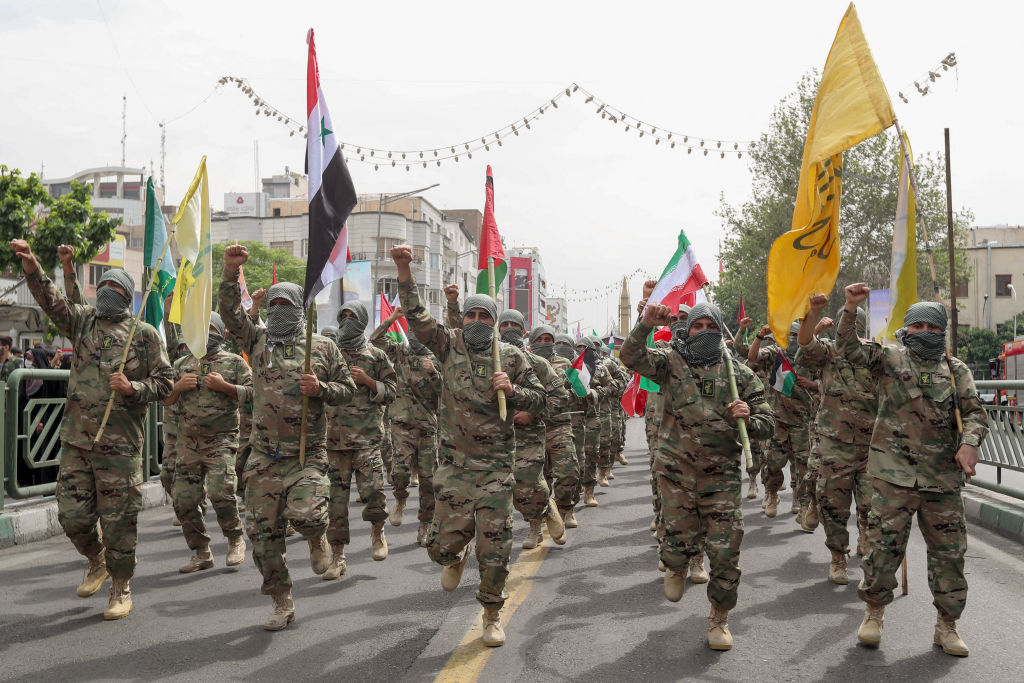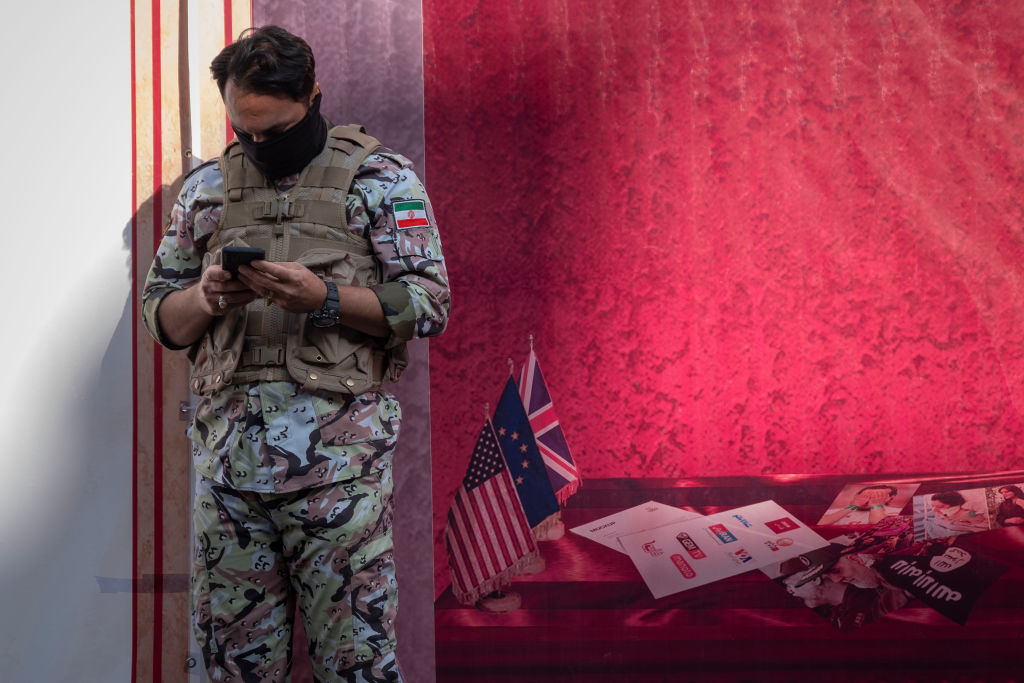
Nearly a dozen weeks into the Iranian people’s anti-government revolt, human rights activists say the death toll has risen to over 400 people—including 60 children—while thousands more remain in detention. Most have been imprisoned, injured, and killed by a diehard group trained by the regime to stifle dissent at all costs.
Daily accounts of brutal crackdowns by the state against its own citizens, tragic killings of individuals, baseless detentions, as well as a series of recurring forced confessions—as practiced by the regime—have further enraged the millions of Iranians who continue to risk their lives for change. Only a handful of protestors—mainly high-profile individuals—have been released on bail in recent days, in an effort to serve the regime’s propaganda.
In addition to other armed forces of the Iranian government, much of the violence carried out against protesters is orchestrated by the Islamic Revolutionary Guard Corps (IRGC).
Known in Farsi as “Sepah e Pasdaran e Enghelab e Eslami,” which translates to the “legion of the guardians of the Islamic Revolution,” the IRGC is one the most powerful, diversified, and heavily-militarized prongs of Islamic Regime’s Armed Forces. This powerful entity reports directly to the country’s Supreme Leader Ali Khamenei and has been sanctioned by the U,S. and others as a terrorist group. The group is weaponized with its own naval, aerospace, intelligence, ground, and foreign forces (Quds), along with its own militia—the parliamentary volunteers known as Basij, whose unrestricted presence in all aspects of the Iranian society remains a profound source of disquiet and rancor among Iranian citizens.
Read More: Iran Has a Long History of Political Activism and Protest. Here’s What To Know
The IRGC was established in 1979 by the founder of the Islamic Republic, Ayatollah Ruhollah Khomeini, with the aim of creating an army of religiously-charged devotees whose sole mission would be to protect the “values” and “ideology” of the “Islamic revolution” from both domestic and foreign threats. Over time, however, the IRGC managed to evolve into both a political and commercial force, growing its grip within the country’s most powerful conglomerates and industries—including oil and gas—and a piercing influence in much of the country’s political affairs.
But at its core, the entity has not forsaken its mission of safeguarding a “revolution” that is now supported only by a slender minority, many of whom are influenced by ideology.
“They are armed, ideologically brainwashed, and easily mobilized,” says a political science student in Tehran who has had multiple encounters with the group. “The Basij is one of the mightiest and most sophisticated creations of the Islamic regime.” He added that the regime’s deeply-rooted manipulation of both men and women has created a “low-cost” yet extremely “effective” defense apparatus.
More from TIME
“When you produce your army through a rock-hard ideology that’s so deeply planted in their minds, entwined in every aspect of their lives, and present in the whole of their identity, then you know that you have an invincible force—a concrete wall that encompasses their entire being that cannot ever be broken,” said the student, who asked not to be named for his own security.
And when Iranians take to the streets—as they have in more than 130 cities across the nation since the Sept. 16 death of 22-year-old Masah Jina Amini while in the custody of the much loathed morality police—their numbers are supplemented by non-believing thugs as well as opportunist individuals (known as plainclothes forces) whose commitment does not necessarily stem from devout ideological beliefs, but rather from professional, political and financial gains by way of association.
Over the weekend, in what’s widely regarded as yet another publicity stunt by the Iranian regime, Iran’s head of Judiciary announced ambiguous remarks regarding the “shutting down” of the notorious morality police that over the years have been renamed and rebranded by the regime. This is while no other government officials – according to the official Islamic Republic Broadcasting – have yet confirmed the annulment of this establishment.
Meanwhile, it is a widely known fact that while such diehard revolutionaries are relatively small in number, they are extremely powerful in force. The individuals TIME spoke with for this piece estimate the group makes up roughly 10% of Iran’s 83 million population—an approximate 8 million devotees whose entire existence is defined in this regime.
Some of these crusaders are criminals who join the forces to have their sentences reduced. Others are opportunist embezzlers who continue to whip up a fortune through their loyalty to this system that has enabled them to score some of the largest commercial, industrial, and petroleum deals, and have a hand in many lucrative dealings within the public and the private sector. Over the years, much of this wealth has further increased as a result of a bankrupt economy due to western sanctions topped with domestic corruption and lack of a regulatory system. This is while so many of the children and family members of these high ranking regime insiders and IRGC officials are spending their fortune overseas–including in the U.S., UK, and Canada.
In the aftermath of the much-contested Iranian presidential election in 2009, the regime brutally and swiftly contained peaceful protests in support of “reformist candidates,” in what became known as the “green movement.” While never confirmed, many in Iran believe that at the time the regime used its regional influence to line up paramilitary forces from Lebanon, Iraq, and Syria to boost attacks against its own people–a practice that to this day is believed to be utilized by the IRGC in containing dissent at home.
At the time General Hossein Hamedani himself—the IRGC commander killed in Syria in 2015 —was responsible for using such forces in stifling the 2009 protests. In his last interview, he confirmed the presence of 45 thousand Basij forces in Tehran as well as thousands of “hooligans and vigilantes” that were kept in safe houses until let out by his command.

“I’ve heard some of these security forces speak Arabic and some who have spoken Farsi with a strange accent.” explained Sara, a 36-year-old Iranian woman, who requested a pseudonym for safety concerns. Sara grew up in an ultra-religious family. While her own parents did not work for the government, they would associate with IRGC family members by way of religious gatherings and government-organized events. When she was in her early 20s and recently divorced, Sara recalls being recruited to join the morality policy forces outside of Tehran.
“I was desperate to make money,” she says, explaining how a friend (whose family was part of the Guards) recommended her to a local mosque to join their Basij. “I said no. I knew right then and there that I didn’t want to be part of that system. As religious as I was, I knew this is not the Islam I practice—no matter the price tag.”
Read More: Why It’s Vital to Center Kurdish Voices in the ‘Woman, Life, Freedom’ Movement
Today, she has let go of her long black veil, known as a chador, and in many ways has abandoned her family who for the longest time kept her in an isolated and confined community of like-minded revolutionaries. She is a single mom of a 15-year-old raising her son and working as an aesthetician in Tehran.
In a fight that in more ways than one is led by Iranian women, what’s perhaps least comprehensible is the ideology of female Basij forces. “This is a sentence I’ve heard over and over from these women: They believe that women are created to give birth and raise zealots—soldiers of Islam,” Sara says, recalling how on numerous occasions she had seen women whose Sepahi and Basij husbands would drop them off at religious events, and then leave with another woman.”
In a recent conversation with a young woman who was held in custody of the Basij for 48 hours after being detained in the protests, Sarah saw her rage and anger firsthand.
“She couldn’t speak for days.” Sara explained how the woman was hung from her hands with a metal ring around her neck. She believes that the woman’s short-lived prison experience was only due to the result of her family’s government connections.
“She was so sick for a few days that we thought she’d been raped. However, she told us that she ‘wished she was,’” underscoring the severe mental and psychological trauma inflicted on the woman. “She told us how the men would come to her and tell her, in detail, all about the other girls they’ve arrested and how each night they pick their favorites.”
But for Sara, none of this comes as a surprise.
“Their minds are sick. They get happy from hurting you and believe that if they can’t have something; you can’t have it either. They believe if the regime is being harsh, it is because they know better,” she explains, adding that the religion they practice is nothing close to the real Islam. “This is not what so many faithful Iranians believe in. This is all propaganda and lies—all guised as their version of Islam.”
Sara and so many other Iranians are hopeful. But even more, they are fatigued, fighting what seems to be an impenetrable force.
“While we may not trust one another, while we know that the protests are unorganized and not in unison, we also have nothing to lose. We’ve seen it all—the worst of the worst. There’s nothing to hold us back from risking it all—losing it all. We do it with the belief that we may be able to win.”
More Must-Reads from TIME
- Introducing the 2024 TIME100 Next
- The Reinvention of J.D. Vance
- How to Survive Election Season Without Losing Your Mind
- Welcome to the Golden Age of Scams
- Did the Pandemic Break Our Brains?
- The Many Lives of Jack Antonoff
- 33 True Crime Documentaries That Shaped the Genre
- Why Gut Health Issues Are More Common in Women
Contact us at letters@time.com